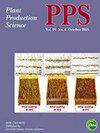Effectiveness of direct application of top dressing with spent coffee grounds for soil improvement and weed control in wheat-soybean double cropping system
IF 1.3
3区 农林科学
Q2 AGRONOMY
引用次数: 4
Abstract
ABSTRACT With increasing annual global coffee consumption, the amount of spent coffee grounds (SCGs) increases. Direct application of SCGs in large agricultural fields can potentially improve soil and control weeds in an environmentally safe manner. However, except for composting, the use of SCGs during cropping has not been implemented thus far because of inhibitory effects on crop growth observed in pot-based studies. We evaluated the effect of a top dressing approach to direct SCG application on crop biomass, soil improvement, and weed control, through double cropping field experiments using wheat and soybean. The field experiments were conducted over six successive cropping seasons in an upland field converted from paddy, and crop and weed biomass as well as soil total carbon and nitrogen were investigated. To avoid growth inhibition, the SCGs were surface broadcasted after crop germination to mimic living mulch. The soil total carbon and nitrogen contents increased significantly under an SCG concentration of 5 kg m−2 or more, approximately 20 months after the first application, whereas SCG application did not significantly affect crop yield except for the first cropping of wheat. In addition, the 10 kg m−2 SCG application reduced the weed biomass by 50% or more during cropping, except for the wheat cropping in the second year. We concluded that top dressing with SCGs after crop germination is an efficient method for sustainable agricultural production, although further detailed studies of SCGs’ effect on the crop growth and soil characteristics are required. Graphical abstract直接施用咖啡渣追肥对小麦-大豆双季制土壤改良和杂草防治的效果
摘要随着全球咖啡年消费量的增加,废咖啡渣的数量也在增加。SCG在大型农田中的直接应用有可能以环境安全的方式改善土壤和控制杂草。然而,除了堆肥之外,由于在基于盆栽的研究中观察到的对作物生长的抑制作用,迄今为止尚未在种植期间使用SCG。我们通过小麦和大豆的双季田间试验,评估了直接施用SCG的追肥方法对作物生物量、土壤改良和杂草控制的影响。在一块由稻田转为旱地的连续六个种植季节进行了田间试验,研究了作物和杂草的生物量以及土壤总碳和总氮。为了避免生长抑制,SCG在作物发芽后进行表面广播,以模拟活的覆盖物。在第一次施用SCG浓度为5 kg m−2或更高的情况下,土壤总碳和氮含量显著增加,大约在第一次种植小麦后20个月,而施用SCG对作物产量没有显著影响。此外,除第二年种植小麦外,施用10 kg m−2 SCG可使杂草生物量在种植期间减少50%或更多。我们得出的结论是,作物发芽后用SCG追肥是可持续农业生产的有效方法,尽管还需要进一步详细研究SCG对作物生长和土壤特性的影响。图形摘要
本文章由计算机程序翻译,如有差异,请以英文原文为准。
求助全文
约1分钟内获得全文
求助全文
来源期刊

Plant Production Science
农林科学-农艺学
CiteScore
5.10
自引率
4.00%
发文量
27
审稿时长
>36 weeks
期刊介绍:
Plant Production Science publishes original research reports on field crops and resource plants, their production and related subjects, covering a wide range of sciences; physiology, biotechnology, morphology, ecology, cropping system, production technology and post harvest management. Studies on plant production with special attention to resource management and the environment are also welcome. Field surveys on cropping or farming system are also accepted. Articles with a background in other research areas such as soil science, meteorology, biometry, product process and plant protection will be accepted as long as they are significantly related to plant production.
 求助内容:
求助内容: 应助结果提醒方式:
应助结果提醒方式:


